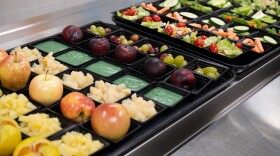In 2024, the Rhinelander Area Food Pantry saw a 43% increase in the number of people needing its services.
It now serves a record 1,020 households.
“We dipped down to about 579 households during COVID, just to put that into perspective,” said Courtney Smith, the Executive Director of the Rhinelander Area Food Pantry.
She says that’s not the only measure by which the pantry has seen a growth in need. People are also visiting the pantry more often.
“What we're hearing from folks right now is that they just aren't able to make ends meet,” said Smith.
Another record that’s been broken for the pantry is the number of children that they’re serving has passed the number of seniors.
Smith says many of the households they serve are what’s considered Asset Limited, Income Constrained, Employed or ALICE households. These are families with working adults putting them above the federal poverty level, but below the basic cost of living.
More than a third of households in Oneida County are at or below the ALICE threshold.
“We have very few unemployed or unhoused folks that shop at the food pantry,” said Smith. “These are just your neighbors and your friends and your family, or it may be that person that you work with, and you don't realize that the cost of living is just so challenging to meet that they're dipping in and supplementing their household income.”
Smith says the Rhinelander Area Food Pantry has been able to meet this rising demand, though it hasn’t been without challenges.
She contributes much of its success to the strong Northwoods community.
“Our community knows that when people have enough to eat, they go to work, that kids learn, that our seniors stay independent and healthy in their own homes longer. We only exist because of our community,” said Smith. “I know that they the community has helped us through other challenges, outgrowing our space, the COVID pandemic, and now cuts to these programs is just another challenge for us that I know our community will support us.”
One of those programs that was recently cut was the USDA’s Local Food Purchase Assistance Program.
The Local Food Purchase Assistance Program
Last year, the Rhinelander Area Food Pantry got about $75,000 worth of fresh produce, meats, and cheese through the program.
They were expecting to receive double that amount this year.
“Produce is super expensive and super perishable. It's something that, if we invest into that, we've got to get right back out the door,” said Smith. “If I'm going to buy food for the food pantry, we're going to buy butter or we're going to buy frozen meat or something along that line, so we do really rely on these programs for that fresh produce.”
On March 7, the Wisconsin Department of Agriculture, Trade and Consumer Protection got a letter from USDA that the program had been cancelled.
The letter stated USDA, “determined this agreement no longer effectuates agency priorities and that termination of the award is appropriate.”
Wisconsin was expected to get more than $5 million through the LFPA program this year.
Kat Becker, owner and operator of Cattail Organics Farm in Athens, was one of the Wisconsin farms that participated in the program.
“We've loved our experience with the LFPA,” said Becker.
She says the program provided clear pricing and clear understanding of what they were going to produce.
A lot of food her farm produce under this program went north of Highway 64 to underserved communities.
“North of Highway 64 in Wisconsin is actually a very produce poor area. I mean, there's some counties north of 64 where the average fresh fruit or vegetable servings that individuals are consuming is one per week outside of the school system,” said Becker, “So extremely poor access in some areas to fresh fruit and vegetables, and that was also true of a lot of the food pantries in the north.”
Becker says another key part of the program that was going to be the focus in this final year that’s now been defunded was shoring up the food system in the region.
It was building up transportation routes and farm capacity to work as mini food hubs.
“Our food system has some really big weaknesses, and so LFPA wasn't just about getting food to food banks, and it wasn't just about helping support farmers produce high quality food for those markets or get them ready for wholesale. It was also about building resilience in the food system,” said Becker.
Becker says this and other USDA cuts will have around 20% impact to her farm’s income. She’s more concerned about newer farms where this program was a much larger portion of their income.
While she would love congress to bring back the funding, Becker doesn’t think that’s realistic.
Instead, she’s turning her attention to the state legislature which is in the process of writing Wisconsin’s new biennial budget.
“I do think that if you look historically at similar programs that came out of COVID and then when the federal funding ended, naturally, so not abruptly, many states made those programs permanent. Wisconsin has done that with other programs in the past,” said Becker.
She thinks that if LFPA had its final year, that at least a portion of the program would have made its way into the state budget.
“It's such an effective program, but I am really hoping that it makes it into this cycle, even if it's a scale back version,” she said.
In the meantime, Becker believes some farms will pull back in investment infrastructures they had planned as they wait to see how USDA program changes and other impacts shake out.
“Not to speak for the whole farming community, but I think many farmers are just trying to be as risk averse as possible in this moment until they feel that they have some amount of stability,” said Becker.







